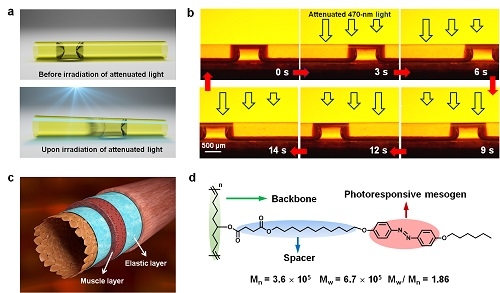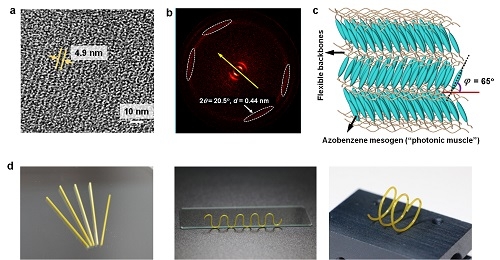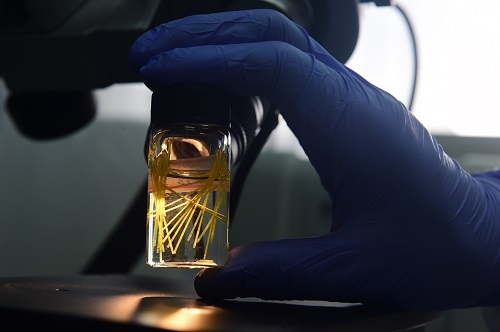Search
Breaking through the restrictions on liquid types, overcoming the difficulties in microfluidic system simplification, and ushering in application prospects in multiple areas
Lab-on-chip that has become increasingly popular in recent years can be described as a technology that integrates basic operating units involved in the fields of biology and chemistry on a chip of a few square centimeters in size, realizes different biological or chemical reaction processes, and analyzes their products. Ideally, lab-on-chip is designed for a variety of purposes including medical inspection; its evolution may bring homeization and popularization of testing and other instruments. To fulfill this vision, the simplification of microfluidic system is imperative.


On September 8, 2016, the latest research achievement in photo-controlled microfluidics of Prof. Yanlei Yu's team under the Department of Materials Science and the State Key Laboratory of Polymer Molecular Engineering of our university (Photocontrol of fluid slugs in liquid crystal polymer microactuators; Nature, 2016, DOI 10.1038/nature19344) was published in Nature. This young research team with an average age of only 29 overcame the difficulties in simplifying microfluidic systems, and creatively employed the independently developed novel liquid crystal photodeformable polymer material to construct microtubule actuators with light response characteristics; all-optical control of various complex fluids, including the commonly used liquids in the field of biomedicine, was achieved with the capillary force resulting from photoinduced deformation of microtubule; the liquids could meander and even climb, and it appears that the team have acquired the magical ability to control water in the microscale.
The first author of the article is Dr. Jiuan Lyu from the Department of Materials Science, Fudan University, and its corresponding author is Prof. Yanlei Yu; Fudan University alumnus and Peking University Prof. Erqiang Chen participated in the collaboration. The research was jointly funded by the National Science Fund for Distinguished Young Scholars, the Key Projects under the National Natural Science Foundation of China, and the Program of Outstanding Academic Leaders in Shanghai. The research findings have been declared for China National invention patents and international PCT patents.

A new driving mechanism: Photodeformation enables capillary force to show its magic
Trace liquid transport is an important issue involving many areas. It's directly associated with the loss-free transfer of expensive liquid medicines, the liquid drives in microfluidic devices and biochips, etc. As microfluidic chips constantly shrink in size in recent years, the number of functional units has been increasing, while the corresponding external driving devices and pipelines have been becoming increasingly complex and bulky. The further simplification of microfluidic system has become a bottleneck restricting the development of microfluidics; fundamentally innovative mechanisms of microfluidic driving are urgently needed.
According to Jiuan Lyu, as light is available to both precisely focus and non-contact control, it has become the best choice for micro-scale fluid manipulation on microfluidic chips. However, reported photo-controlled liquid motions were subjected to restrictions to certain extents. For instance, light-responsive compound needs to be added to samples to control trace liquid through the photoinduced Marangoni effect, which may inevitably bring about sample contamination; where the heat generated by the laser irradiating the liquid is used for control, the resulting temperature variation may impair its application in biochemistry; if the trace liquid is controlled with photoinduced surface wettability gradient, the operation is merely applicable for a few specific liquids, while only short-range linear motion is available, which falls short of practical requirements; simplex drive paths, short drive distance, and limited categories of drivable liquids are key shortcomings of the existing photo-controlled microfluidic technology. It is observed that there is still a lot of room for exploration in the extensively applicable light-controlled microfluidic technology, and further R&D is urgently needed.
Prof. Yanlei Yu's team has been engaged in the studies on liquid crystal polymer materials and their photodeformation properties. Based on rich relevant experience, the use of the capillary force produced by the photodeformation of microtubules has become the fundamental orientation for the team to seek the innovation of liquid drive mechanism and make breakthroughs in existing mechanisms.
The wetting liquid can move spontaneously to the thin end of tapered capillary under the axial asymmetric capillary force. Born out of this principle, the team ingeniously designed and constructed a micron-scale liquid crystal polymer microtubule actuator where tube diameter could change asymmetrically under the stimulation of commonly used LED visible light sources; the actuator has the dual functions of fluid channel and driving pump. Through the changes in capillary force induced by the variation of tube diameter, the magic of controlling the droplet motion in microtubule by means of light was realized in a completely different way.

Bionic design: From arterial blood vessels to new-generation liquid crystal polymer materials
Traditional microfluidic devices are usually constructed from non-responsive materials such as silicon and glass. Microfluidic devices made of such materials need to be connected to many external driving devices to manipulate trace liquids. Moreover, the previously reported liquid crystal polymer materials were mostly crosslinked liquid crystal polymers, while the chemical crosslinked networks cause the materials to be insoluble and infusible, which failed to the practical processing requirements for actuators in three-dimensional forms. How to design a novel liquid crystal polymer material with excellent processability that can be made into microtubule actuators? Upon clarification of the liquid drive mechanism, this question once became the focus of Prof. Yanlei Yu’s team.
By learning from nature, the team noticed that the walls of biological arterial vessel wall can withstand pressures up to 2000 mmHg thanks to their layered structures; from that perspective, the walls can be described as extremely tough. Inspired by this, the bionic design of a new structure of linear liquid crystal polymer material finally became the solution to the problem. Through the ring opening metathesis polymerization, the team successfully produced a novel photodeformable liquid crystal polymer material with an ultra-high molecular weight. Such linear liquid crystal polymer is free of chemical crosslinked structure, and offers excellent solubility, fusibility and processability; moreover, it can be self-assembled into a nano-layered structure similar to biological arterial vessel with excellent mechanical properties. With an elongation at break that is up to 100 times that of traditional crosslinked liquid crystal polymer, it can be made into various forms through the simple solution processing method, thus being considered a new-generation high-performance liquid crystal photodeformable polymer material. From that material, Prof. Yu Yanlei's team has successfully constructed straight, Y-shaped, S-shaped and spiral self-supporting microtubule actuators designed to control various liquids to move with light.
Multi-field applications: Groundbreaking system simplification scheme
Based on the innovations in materials and driving mechanisms for microfluidic devices, the research findings of Prof. Yanlei Yu's team have effectively overcome the deficiencies of the existing light-controlled microfluidic technologies. Aqueous solution, serum protein solution, cell culture fluid, ethanol, vegetable oil, petrol...The designed and constructed microtubule actuators enable the optical control of various polar and non-polar liquids, complex fluids, or even the transport of biological samples, thus being considered a brand-new concept of microfluidic technology.
Based on such technology, the direction and rate of liquid motion (up to 5.9 mm/s) can be accurately controlled by simply changing the lighting conditions to achieve long-range motion that was impossible in the past (continuously driving the trace liquid to move over 50 mm in microtubule actuators of 0.5 mm in diameter); the technology even enables the trace liquid to get stirred and blended, climb overcome the gravity, and create S-shaped and helical paths of motion. Foreign peer experts described the technology as 'superior to all existing technologies; very nice piece of work with real openings', and fully affirmed its application prospects, believing that the technology was bound to arouse widespread interest among scientists in many fields.
According to Prof. Yanlei Yu, as a fundamental study, the microtubule actuator is expected to fulfill its potential in biomedical equipment, biochemical test & analysis, microfluidic reactors, lab-on-chip, and other fields, and offer a considerable value of application. Taking biochemical test & analysis as an example; the reaction, separation and purification of liquids can be accomplished with the microtubule actuator. Above all, in addition to fulfilling corresponding functions, the microtubule actuator can also "slim down" microfluidic systems. When light source turns into a means of control, external drive device is no longer necessary, and it's thus possible to simplify systems dramatically. Lab-on-chip may take a new step with its power toward the high-level integration.







